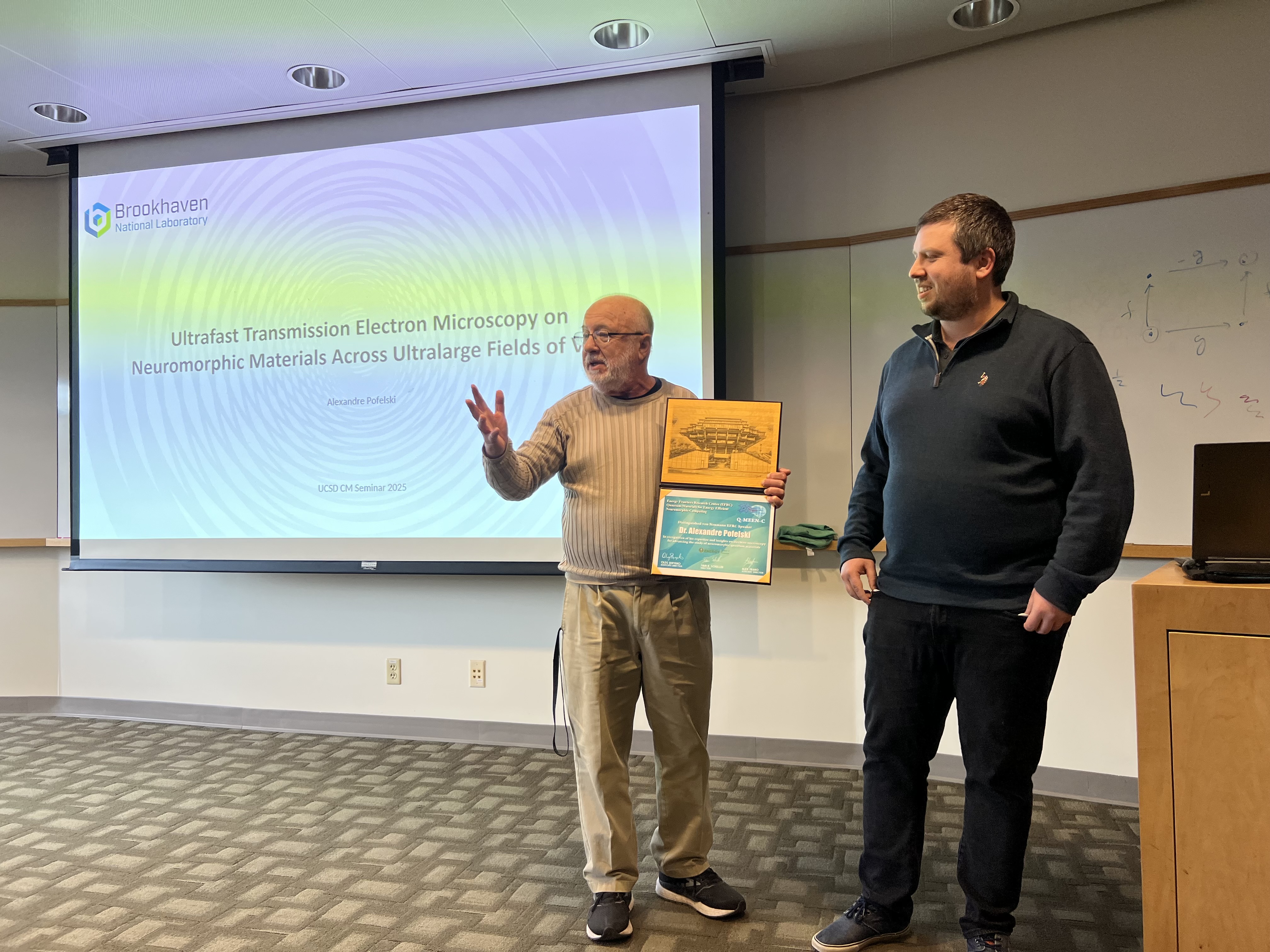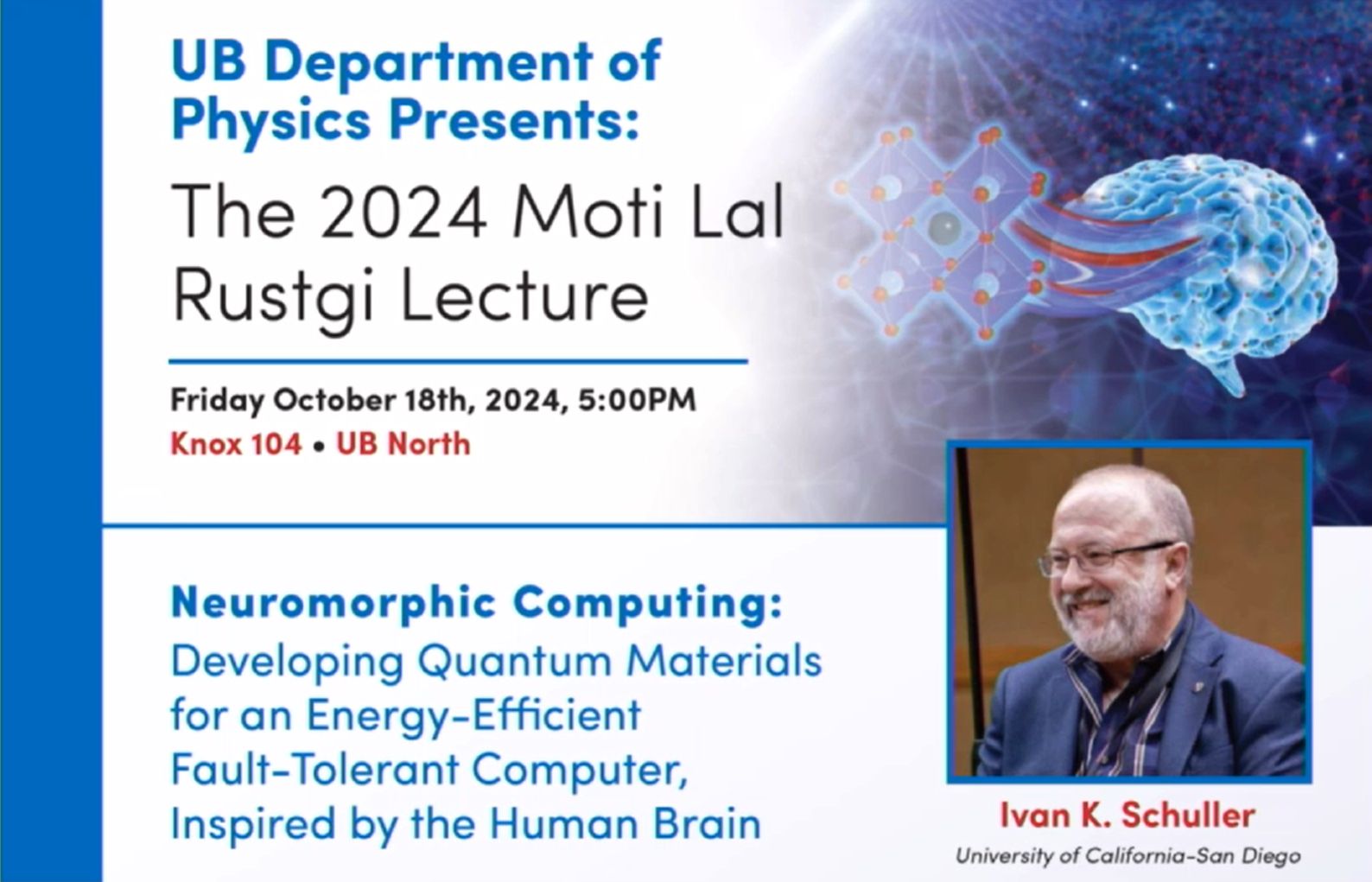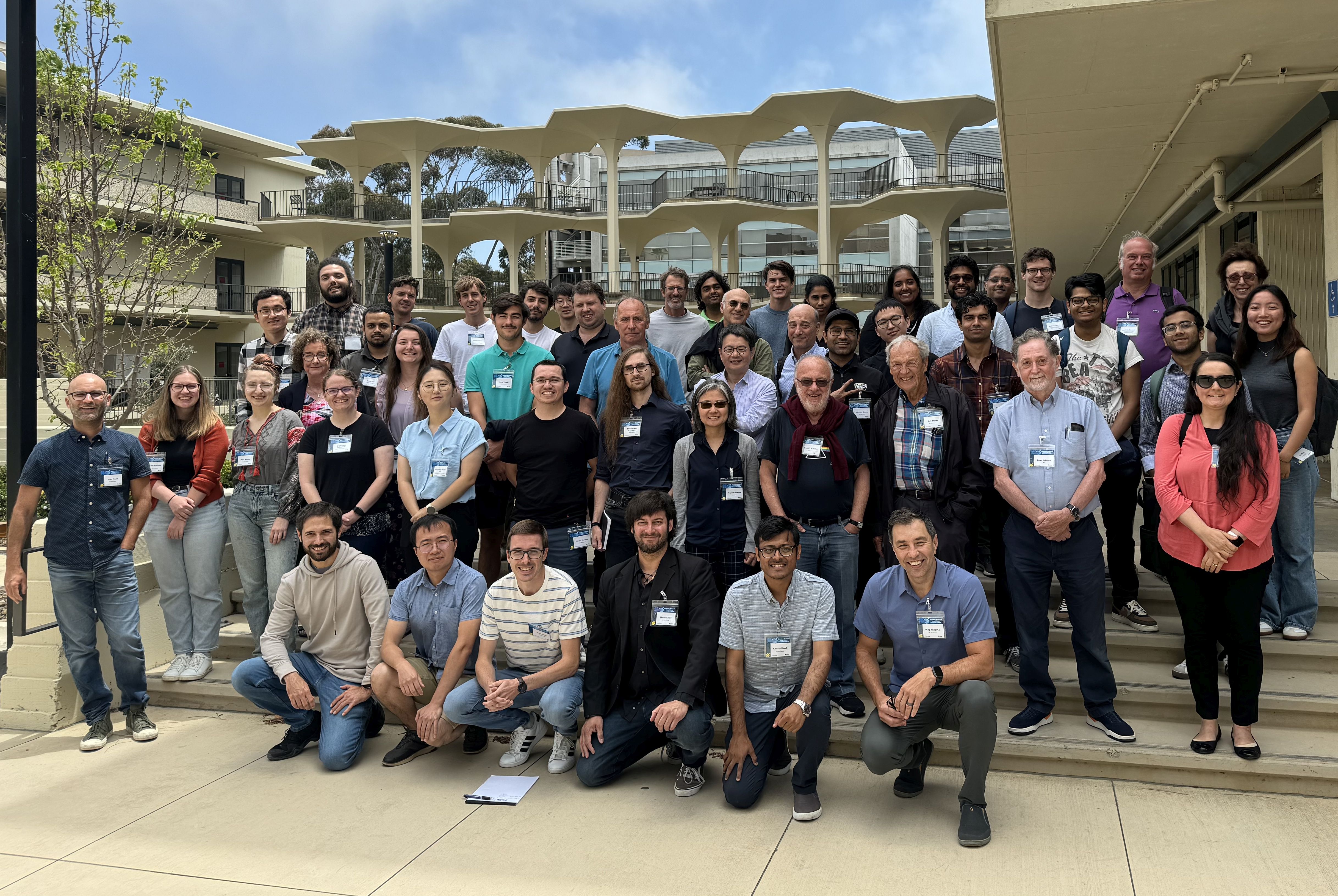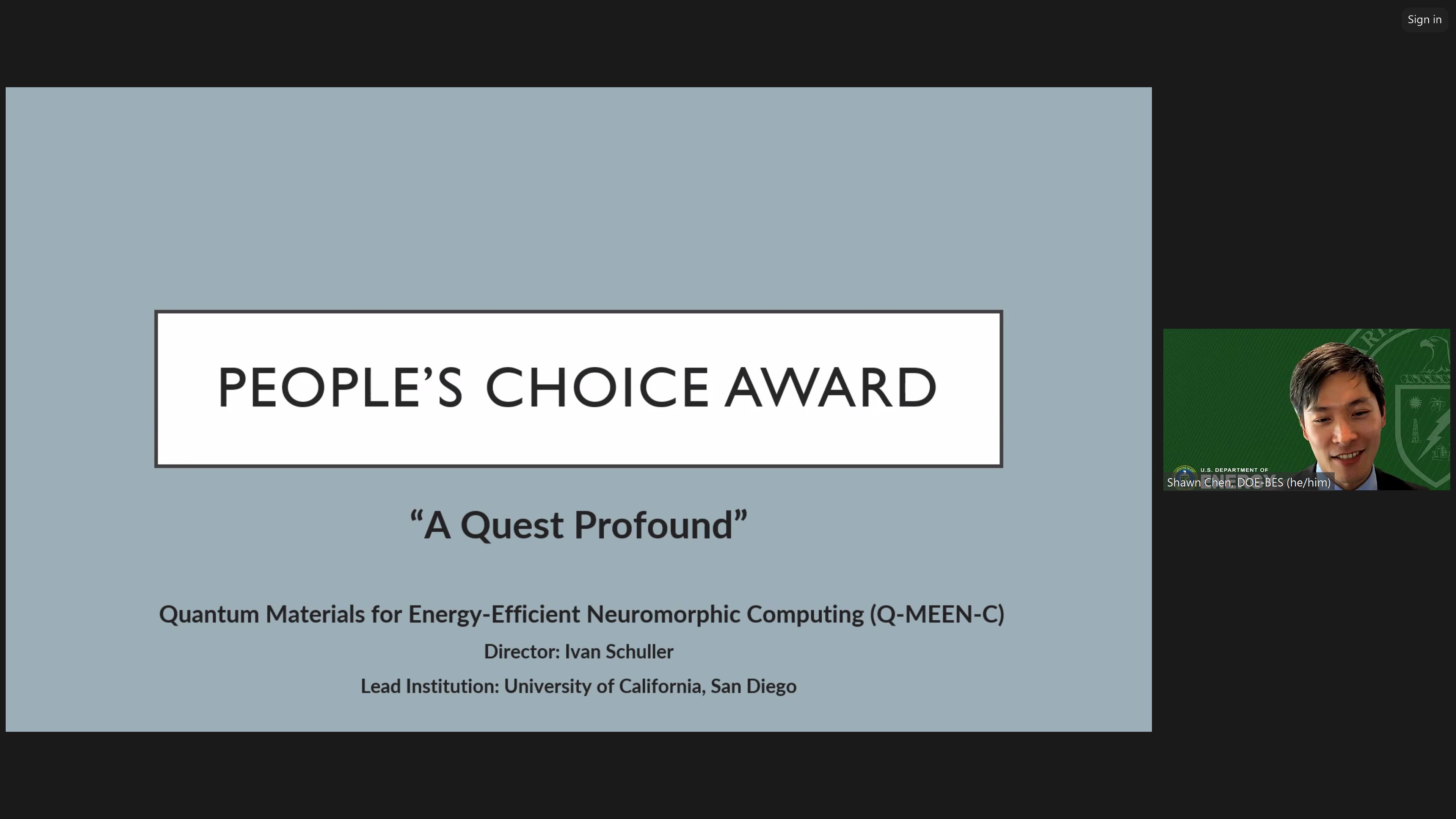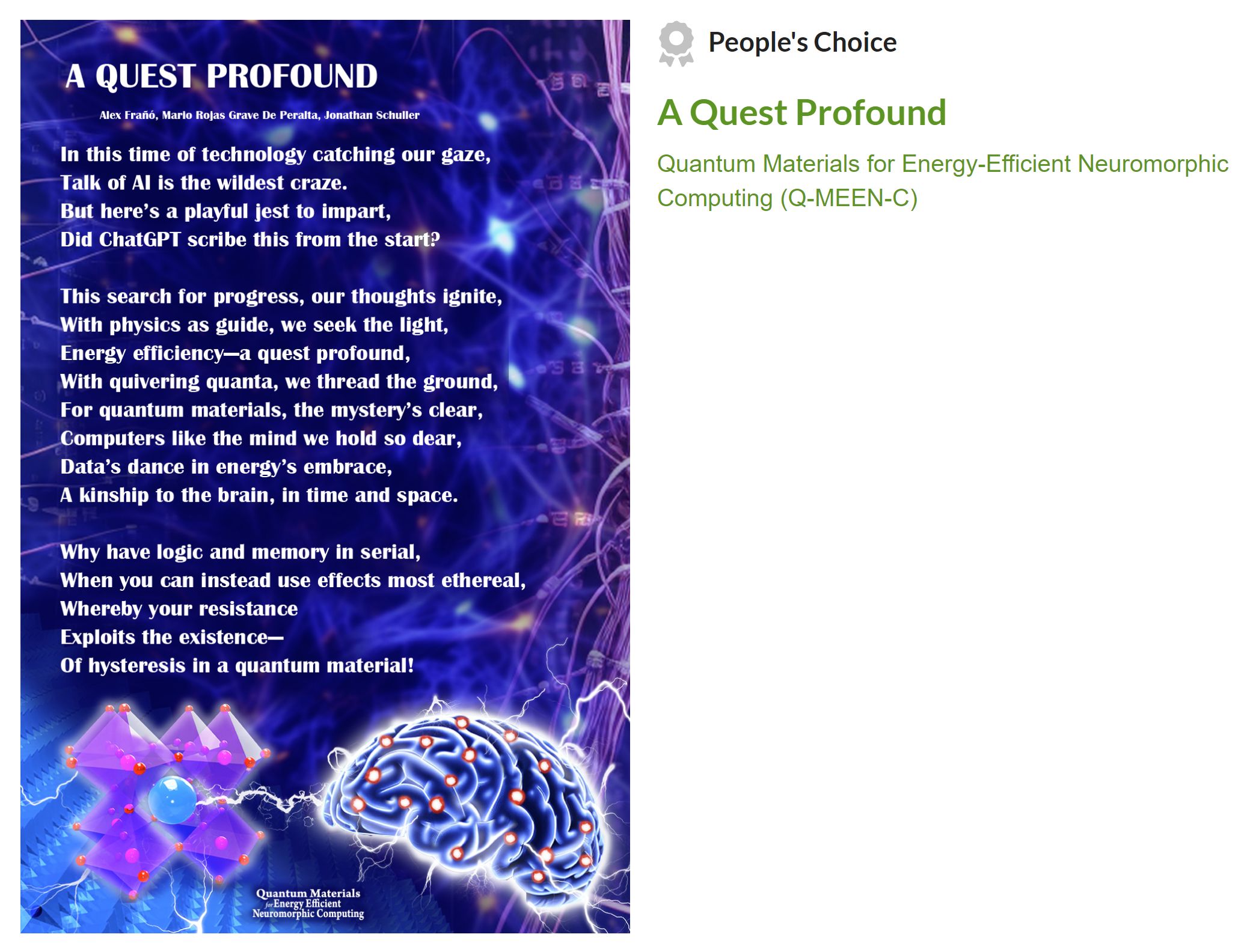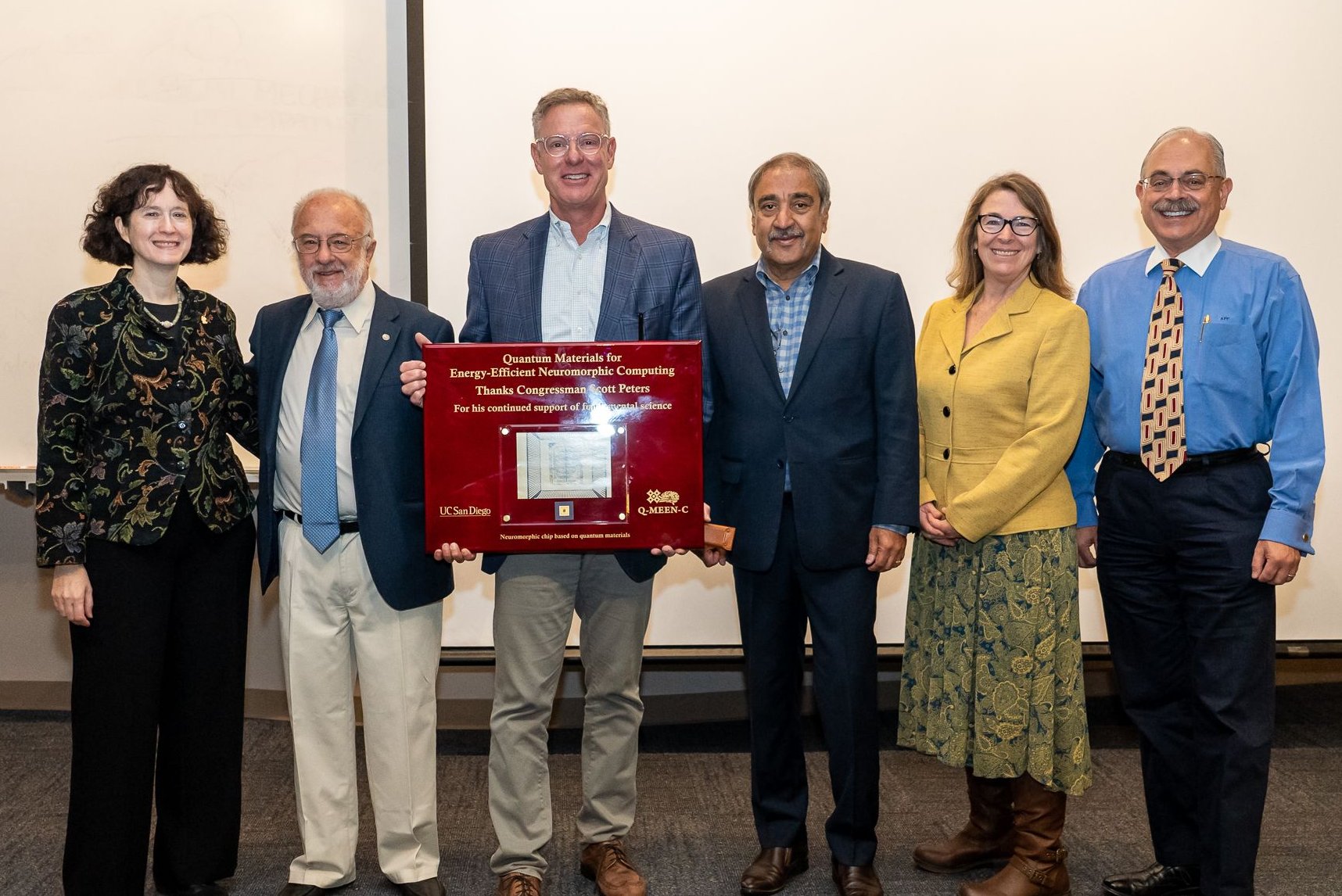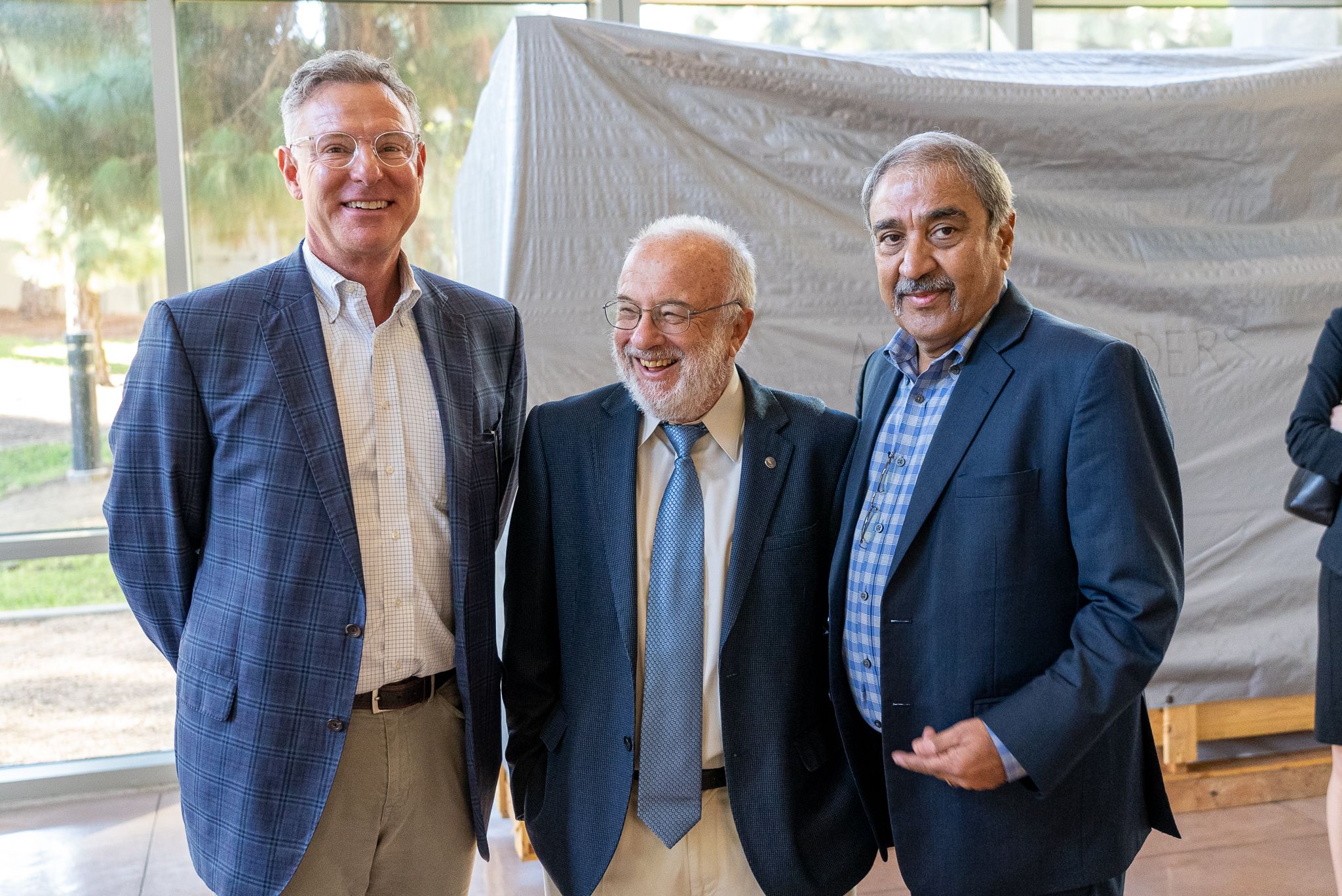.

Colloquium on Neuromorphic Computing by Marcelo Rozenberg at NYU
Rozenberg (left) Pictured with Q-MEEN-C Colleague Andrew Kent
Q-MEEN-C's Marcelo Rozenberg from Université Paris-Cité and Integrative Neuroscience and Cognition Center Simple Memristive Circuits, recently visited NYU on October 10 to give a colloquium on Neuromorphic Computer.
Posted 10.12.2025
.

Q-MEEN-C Research Featured as Argonne National Laboratory Science Highlight
"Taking a closer look at a metal-insulator transition material"
An article at the Advanced Photon Source (APS), at Argonne National Lab, features the research conducted within Q-MEEN-C, where the metal insulator transition was studied using state-of-the-art x-ray experimental tools. Written by Christy Brownlee (APS).
ANL Highlight by Christy Brownlee.
Posted 8.26.2025
Read Full Article Here
.
Q-MEEN-C holds annual 2025 All-Hands Meeting
The collaborative event was held in UCSD's Mayer Hall from July 9 to 10.
Funded by the DOE's Basic Energy Sciences (BES) program, Q-MEEN-C strives to excel in the field of energy-efficient materials and we are thrilled to share the success of our EFRC’s 2025 Annual All-Hands Meeting, which brought together physicists from across the United States and abroad for two days of inspiring discussions and groundbreaking ideas. The event was a hub of innovation, with attendees exchanging insights and forging collaborations that promise to shape the future of our field. The meeting not only highlighted the remarkable work being done but also set the stage for continued partnership and discovery in the years ahead.
Posted 8.1.2025
.
Von Neumann Talks present Dr. Alexandre Pofelski
Q-MEEN-C's Von Neumann Talks presented distinguished EFRC speaker, Alexandre Pofelski, Postdoctoral Researcher at Brookhaven National Laboratory Ridge, New York. Dr. Pofelski spoke of his extensive expertise and insight on electron microscopy for advancing the study of neuromorphic quantum materials.
Posted 4.18.2025
.
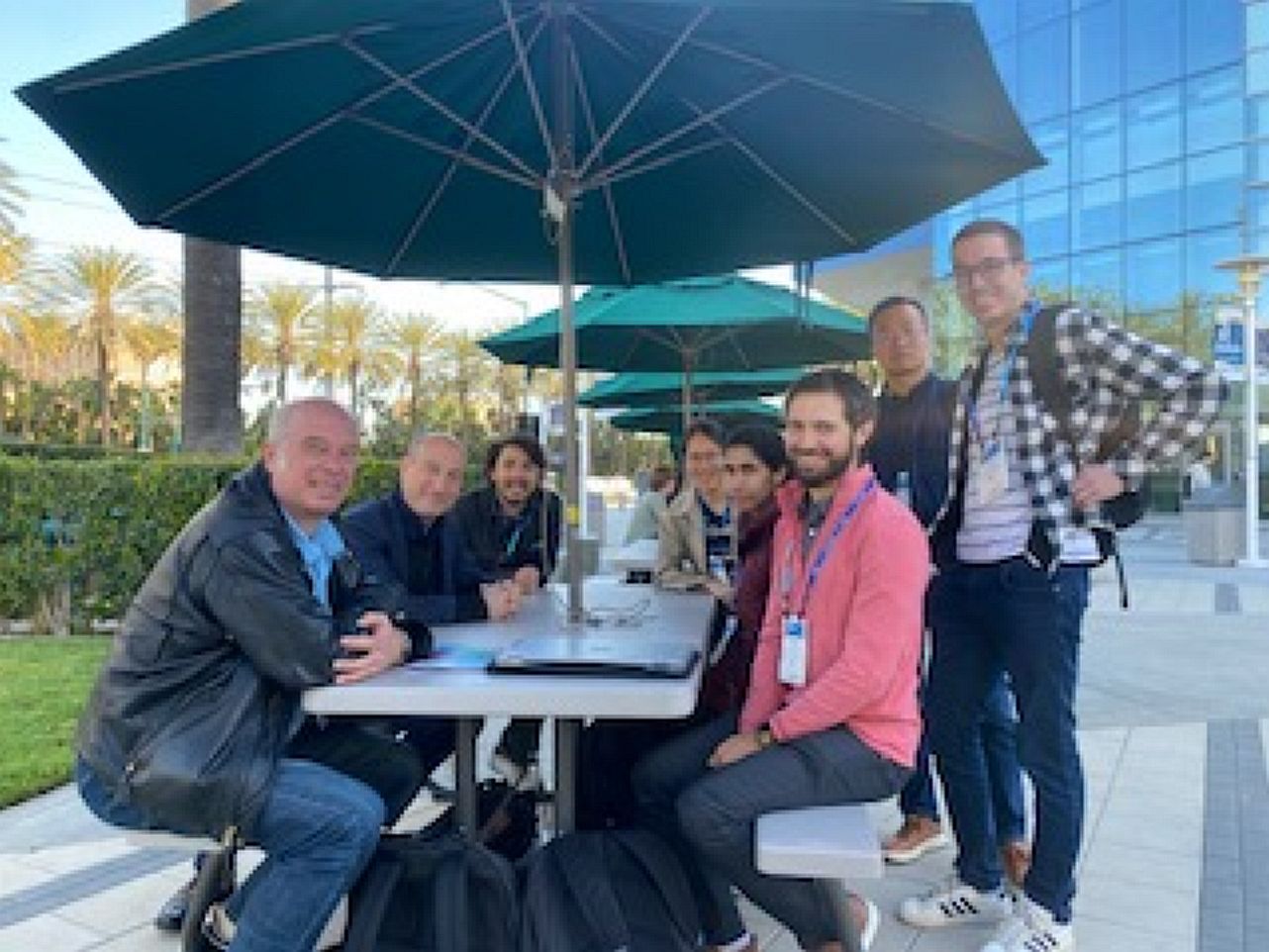
.

The Future of Computing is Physics
How physics research has shaped modern life
Q-MEEN-C directors, Ivan Schuller and Oleg Shpyrko were recently interviewed on the relevance of physics to AI, and the potential of efficient neuromorphic computing.
Article by Michelle Franklin for UC San Diego Today.
Posted 12.10.2024
Read Full Article Here
.
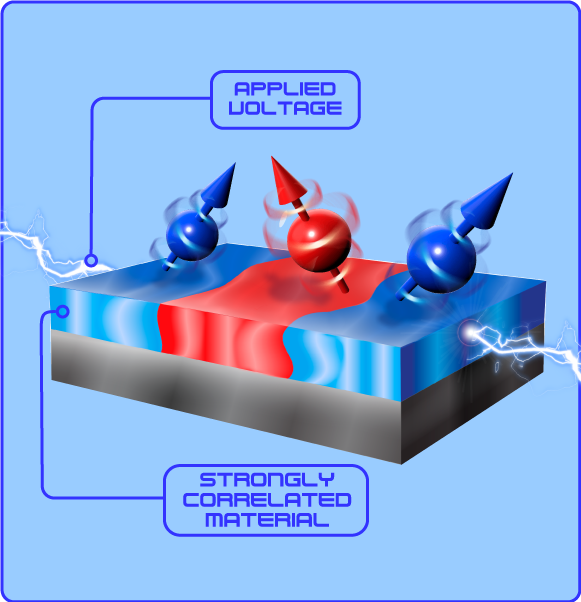
Q-MEEN-C's recent work on Tuning Magnetism with Voltage featured as a DOE Highlight
Experiments show that applied voltage can dramatically alter the magnetic properties of quantum materials.
The US Department of Energy: Office of Science released their more recent highlights featuring the work of Q-MEEN-C researchers who discovered that applying voltage to LSMO in its magnetic phase causes the material to split into regions with distinct magnetic properties. This breakthrough could lead to energy-efficient methods for controlling magnetism.
Posted 11.20.2024
Read Full Highlight Here
.
University of Buffalo - Rustgi Lecture 2024
October 18, 2024, Ivan Schuller gave the prestigious Rustgi lecture at the State University of New York Buffalo.
The University of Buffalo presented the 2024 Moti Lal Rustgi Lecture on Friday, October 18, 2024.
Speaker, Ivan K. Schuller, distinguished professor from UC San Diego presented his talk on Neuromorphic Computing: Developing Quantum Materials for an Energy-Efficient Fault-Tolerant Computer, Inspired by the Human Brain.
Posted 10.21.2024
Watch Lecture Here
.
Q-MEEN-C holds annual 2024 All-Hands Meeting
The collaborative event was held in UCSD's Mayer Hall from July 18 to 19.
Funded by the DOE's Basic Energy Sciences (BES) program, Q-MEEN-C strives to excel in the field of energy-efficient materials and we are thrilled to share the success of our EFRC’s 2024 Annual All-Hands Meeting, which brought together physicists from across the United States for two days of inspiring discussions and groundbreaking ideas. The event was a hub of innovation, with attendees exchanging insights and forging collaborations that promise to shape the future of our field. The meeting not only highlighted the remarkable work being done but also set the stage for continued partnership and discovery in the years ahead.
Posted 7.22.2024
.
Spiking Nano-oscillators Provide New Insight into Quantum Materials and Advanced Computing
UCSD News highlights a recent interdisciplinary discovery of unusual dynamic synchronization properties of spiking oscillators in correlated Mott-materials, which can serve as the basis of the neuromorphic computers performing complex operations similar to human brains. This work was primarily done in Prof. Ivan Schuller's lab and was published in PNAS.
This work is led by Erbin "Ben" Qiu, a Graduate Student in the Schuller lab, Henry Navarro, a postdoc in the Schuller lab, two former postdocs from Schuller lab - Dr. Pavel Salev and Dr. Felipe Torres, as well as Prof. Bob Dynes.
Congratulations to Ben and Ivan, as well as Pavel, Felipe and Bob on their remarkable discoveries !
Posted 12.21.2023
Read Article Here
.
Q-MEEN-C Poem Wins People's Choice Award
"A Quest Profound" Winner of the People's Choice Award at the Energy Frontier's 2023 Poetry of Science Art Contest II.
A modern poem with three stanzas of coupled rhymes (AABB). A humorous introductory quatrain about the current tech scene, followed by an octet describing the process of energy-efficiency using quantum material in new computers that mimic the human brain, and a concluding limerick to sum up the mission of the Energy Frontiers Research Cener.
Congratulations to the authors Alex Frañó, Mario Rojas, and Jon Schuller!
Posted 9.18.2023
Full Contest Here
.
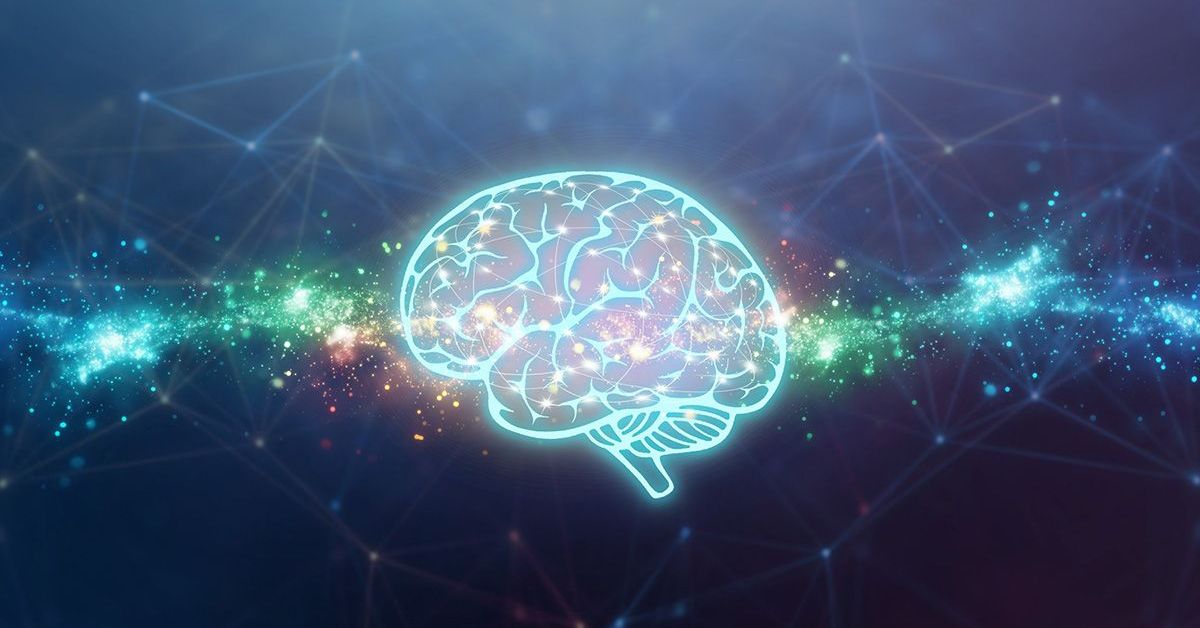
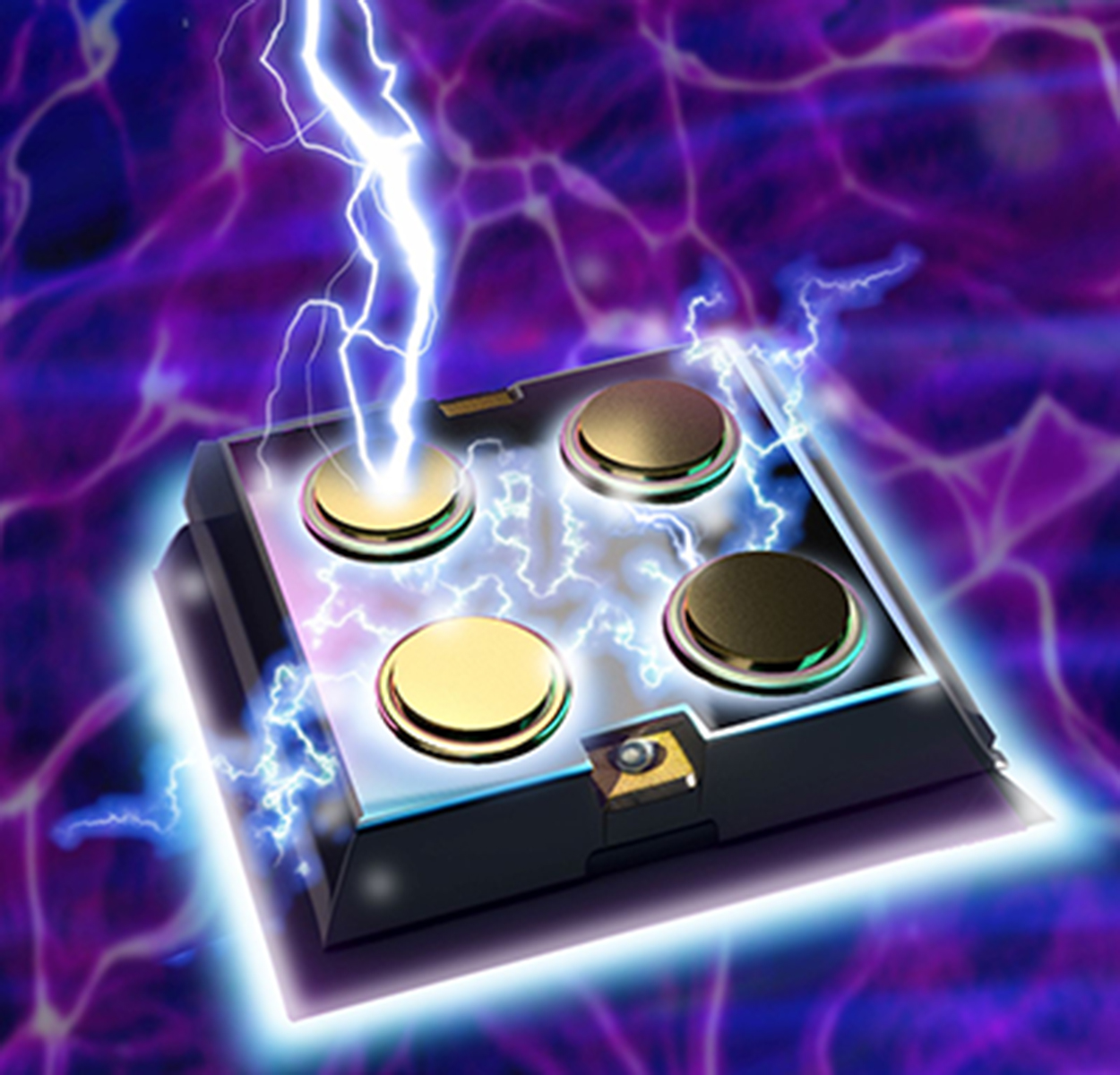
Quantum Material Exhibits “Non-Local” Behavior That Mimics Brain Function
New research shows a possible way to improve energy-efficient computing
"We often believe computers are more efficient than humans. After all, computers can complete a complex math equation in a moment and can also recall the name of that one actor we keep forgetting. However, human brains can process complicated layers of information quickly, accurately, and with almost no energy input: recognizing a face after only seeing it once or instantly knowing the difference between a mountain and the ocean. These simple human tasks require enormous processing and energy input from computers, and even then, with varying degrees of accuracy."
Written by Michelle Franklin
Posted 8.7.2023
Read Full Article
.
Organismic Materials for Beyond Von Neumann Machines
There is growing interest in emulating "organismic" features of intelligence in computing machines, using materials that can respond to their environment in a manner similar to organisms.
The elementary basis of intelligence in organisms with a central nervous system includes neurons and synapses and their complex interconnections forming neural circuits. In non-neural organisms such as slime mold with gel-like media, viscosity modulation enables adaptation to changing environments. At a larger scale, collective intelligence emerges via social interactions and feedback in animal colonies. Learning and memory are therefore multi-scale features that evolve as a result of constant interactions with the environment.
Posted 5.30.2023
Read More
.
ECE Distinguished Colloquium at University of Illinois Urbana Champaign
Apr 13, 2023. Q-MEEN-C Director, Prof. Ivan K. Schuller, at the ECE Distinguished Colloquium at UIUC where he discussed how data manipulation in its many forms drives our modern civilization, and how the continuous increase in hardware packing density and phenomenal decrease in cost has been key to the development of the information revolution. Therefore, fueling the discovery of revolutionary scientific concepts such as quantum mechanics, coupled with the development of quantum materials and devices.
Posted 5.5.2023
Read More
.
Meeting with Carver Mead, the father of Neuromorphic Computing, at the Kyoto Awards.
Erbin Qiu , Ivan Schuller, and Carver Mead
Carver Mead is a pioneer of modern microelectronics who has made contributions to the development and design of semiconductors, digital chips, and silicon compilers, technologies which form the foundations of modern very-large-scale integration chip design. Focusing his efforts, during the 1980s, on electronic modelling of human neurology and biology, creating "neuromorphic electronic systems."
Posted 5.5.2023
.
Alex Frañó gives the Doc Morris Lecture at San Diego State University
On April 21st, Alex Frañó visited San Diego State University (SDSU) to give the Doc Morris Lecture where he talked about Q-MEEN-C research on how quantum materials will be the next platform for neuromorphic computing.
SDSU Physics presents the annual public lecture to make physics and science accessible to general audiences. The lecture honors SDSU Physics’ most senior faculty member Prof. Richard H. Morris.
Posted 5.2.2023
Read Full Article
.
EFRC meet-up at NYU
Alex Frano and Andy Kent
Q-MEEN-C's Alex Frano of UC San Diego travelled to New York this April to meet up with Andy Kent of New York University. The meetup covered various topics but principal among them was the dicussion of spin-torque oscillators based on quantum materials for neuromorphic computing.
Posted 4.10.2023
.
EFRC meeting at the APS March meeting 2023
Q-MEEN-C’s director Ivan K. Schuller along Yimei Zhu and Shriram Ramanathan
The APS March Meeting connects scientists and students worldwide with the potential of exciting new collaborations across academia, industry, and major labs. Students, early-career physicists, and experienced professionals benefit from the networking and this year was no exception by bringing together Q-MEEN-C’s director Ivan K. Schuller, of UC San Diego with important principal investigators like Yimei Zhu from Brookhaven National Labs and Shriram Ramanathan of Rutgers University.
The Las Vegas in-person meeting ran from March 5–10, with a virtual meeting also taking place from March 20–22, 2023.
Posted 4.2.2023
.

Q-MEEN-C article chosen as Journal of Applied Physics Most-Read Scilights from 2022
Scilights showcase the most interesting research across the physical sciences published in AIP Publishing journals, including Journal of Applied Physics.
A Scilight, or science highlight, is an article written by professional science writers which briefly summarizes newly published research, emphasizing its importance to a particular field. With nearly 17,000 downloads, Superconducting neural networks with disordered Josephson junction array synaptic networks and leaky integrate-and-fire loop neurons, a publication by Q-MEEN-C’s Robert C. Dynes and Uday S. Goteti, is one of these most-read articles from 2022 that were chosen by the journal editors for Scilights.
Posted 3.30.2023
Read Full Article
.
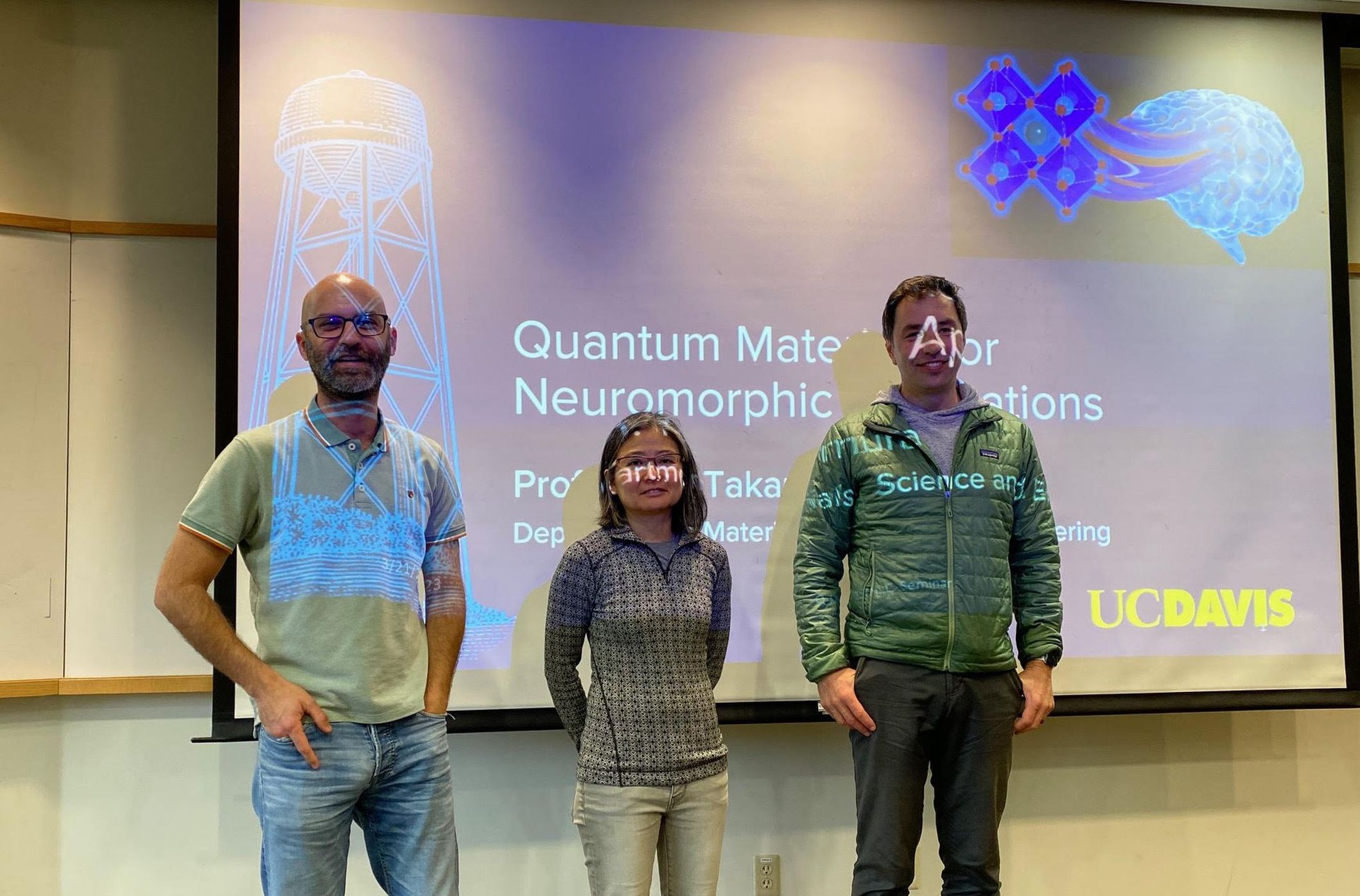
Yayoi Takamura visits UCSD
Yayoi Takamura talks of her ongoing research during UCSD visit
On March 21, Professor Yayoi Takamura of UC Davis, visited UCSD to discuss her ongoing research with fellow Q-MEEN-C principal investigators and directors. She spoke of her research on quantum materials and fostered new and exciting collaborations to better understand and discover novel materials to develop a platform for neuromorphic computing.
Posted 3.22.2023
.

UCSD Researchers Receive DOE Funding to Continue Exploring Quantum Materials
The first generation of computers used vacuum tubes. The second, transistors and the third, integrated circuits. Each new generation allowed computers to be faster, smaller and more energy efficient. Now, as the world stretches beyond the limits of integrated circuits, what does the fourth generation of computing look like.
Reviewed by Laura Thomson for AZO Quantum
Posted 3.19.2023
Read Full Article
.

Physicists Receive $12.6M From Department of Energy to Continue Exploring Next-Generation Computing
With renewed funding, UC San Diego-based Q-MEEN-C moves one step closer to neuromorphic computing
Written by Michelle Franklin for UC San Diego Today
Posted 9.28.2022
Read Full Article
.
NYU Meetings to discuss collaboration between Schuller, Kent and Takamura groups.
Research on voltage driven collective magnetic modes in quantum materials.
Posted 9.27.2022
.
Q-MEEN-C Director and Principal Investigators meet for NYU Symposium
EFRC Director, Ivan K. Schuller, meeting with Andy Kent, Axel Hoffmann, and Eric Fullerton at NYU for Spin Dynamics at the Nanoscale Symposium in honor of Andy Kent.
Posted 9.24.2022
Read Full Article
.

Q-MEEN-C's Axel Hoffmann among group of UIUC faculty members tasked with energy-efficient research for a brighter future.
A chance to shine': Three MatSE faculty serving four DOE-awarded centers addressing the U.S.' energy efficiency
Posted 9.16.2022
Read Full Article
.

Perovskite nickelate device reconfigurable for different functions by Senam Tamakloe for MRS Bulletin talking about research by Q-MEEN-C's Shiriram Ramanathan
Posted 9.15.2022
Read Full Article
.
.
Q-MEEN-C 2 Launched in Ceremony of Funding Renewal
The U.S. Department of Energy's EFRC
Q-MEEN-C 2 is officially launched in a ceremony of renewed funding that featured distinguished guests such as California's 52nd Congressional District Representative Scott Peters and UC San Diego Chancellor Pradeep Khosla who honored attendees with their words after a comprehensive introduction by Director Ivan K. Schuller, reminding us of the center's importance in present and future science:
"During the semiconductor revolution, materials science helped developers identify silicon and germanium as ideal materials. It is the same now, where we see quantum materials as the key to increasing computational power while also decreasing local energy consumption."
Posted 9.3.2022
.

Q-MEEN-C studying materials whose traits resemble those of the human brain
Humanity is far from having artificial computers that can match the capabilities of the human brain, outside a narrow range of well-defined tasks. Will we ever capture the brain’s magic? To help answer that question, MRL’s Axel Hoffmann recently led the writing of an APL Materials “Perspectives” article that summarizes and reflects on efforts to find so-called “quantum materials” that can mimic brain function.
Posted 8.3.2022
Read Full Article
.

Marcelo Rozenberg appointed Editor of Frontiers in Neuroscience
Joined as Associate Editor for the specialty section of Neuromorphic Engineering.
Q-MEEN-C Principal Investigator, Marcelo Rozenberg, has been recently appointed to the Editorial Board of Frontiers in Neuroscience in the Neuromorphic Engineering specialty section as Associate Editor.
Posted 5.25.2022
Read Full Article
.

Q-MEEN-C's Vitaliy Lomakin named an IEEE Fellow
Citation: "for contributions to theoretical and computational electromagnetics"
IEEE Fellow is a distinction conferred by the Board of Directors upon select IEEE members whose extraordinary accomplishments in any of the IEEE fields of interest are deemed fitting of this prestigious grade elevation. The total number selected in any one year does not exceed one-tenth of one percent of the total voting Institute membership.
Posted 12.15.2021
.

Q-MEEN-C's Mark Stiles named an IEEE Fellow
Citation: "for contributions to spintronics devices and data storage"
IEEE Fellow is a distinction conferred by the Board of Directors upon select IEEE members whose extraordinary accomplishments in any of the IEEE fields of interest are deemed fitting of this prestigious grade elevation. The total number selected in any one year does not exceed one-tenth of one percent of the total voting Institute membership. Listen to Stiles' invited podcast in which he shares his insights on the IEEE Magnetics Society's work as it relates to neuroscience and brain-inspired computing technologies. He also offers his advice to students and young professionals who might be interested in relevant technologies fields.
Posted 12.15.2021
Watch Episode 19 Here
.

Q-MEEN-C's Andrew Kent named an IEEE Fellow
Citation: "for contributions to the application of spin-transfer torques in nano-scale devices"
IEEE Fellow is a distinction conferred by the Board of Directors upon select IEEE members whose extraordinary accomplishments in any of the IEEE fields of interest are deemed fitting of this prestigious grade elevation. The total number selected in any one year does not exceed one-tenth of one percent of the total voting Institute membership.
Posted 11.23.2021
.

Q-MEEN-C's Julie Grollier awarded the 2021 Irène Joliot-Curie Prize
The Irène Joliot-Curie Prize is awarded annually by the French Academy of Sciences. The "Female Scientist of the Year" category honors women who have made a contribution in the public or private research field through the significance, and national and international recognition of their work in science.
Posted 11.23.2021
Read Full Article
.

Q-MEEN-C researchers report large interfacial spin-charge conversion in gold multilayers
Authors: Mohammed Salah El Hadri, Jonathan Gibbons, Yuxuan Xiao, Haowen Ren, Hanu Arava, Yuzi Liu, Zhaowei Liu, Amanda Petford-Long, Axel Hoffmann, and Eric E. Fullerton
Interfacial spin-orbit effects in gold convert charge currents into angular momentum-carrying spin currents and vice versa. These spin currents can be used to control spin torque nano-oscillators for neuromorphic computing. Q-MEEN-C scientists have maximized these effects by creating extremely thin gold-silicon multilayers with many interfaces. These structures were shown to produce large spin-charge conversion efficiencies. In the figure above, (a) shows the process of lateral charge-to-spin conversion and (b) shows the efficiency of conversion on a log-log plot as a function of the thickness of the gold.
Posted 11.04.2021
Read Full Article
.

Q-MEEN-C's Axel Hoffmann receives American Physical Society’s 2022 David Adler Lectureship Award in the Field of Materials Physics
Citation: "For pioneering work, engaging lectures, and comprehensive reviews advancing the understanding of spin transport and magnetization dynamics in magnetic multilayers."
Posted 10.28.2021
Read Full Article
.

Q-MEEN-C researchers simulate artificial brain networks with new quantum materials
The figure demonstrates brain-like emergent properties of quantum-materials-based devices
Posted 9.30.2021
Read the published paper
Read the 9/3/2021 UCSD press release
.

Q-MEEN-C researchers demonstrate the first quantum material spintronic resonator for applications in neuromorphic computing
In the hybrid metal‐insulator‐transition oxide (V2O3)/ ferromagnetic metal (Ni, Fe) nanoconstriction spin resonator shown above , (a) is the materials geometry and (b) is a scanning electron microscopy image of the nanoconstriction showing the current flow.
Spin resonators excite spin waves that convert a high frequency signal into a dc voltage; they have been used as synapses in oscillator based neuromorphic circuits. By incorporating a metal‐insulator‐transition oxide, spin resonators were demonstrated to have hysteresis and memory of their prior state, a new characteristic for spin resonators (which previously only incorporated ferromagnetic metals) and an important characteristic for oscillator-based synapses.
Posted 7.23.2021
Read Full Article
.

Q-MEEN-C Researchers Report on Topotactic Transformations in Cobaltite Thin Films with Potential Applications in Neuromorphic Computing
This paper is featured as an Editors' Suggestion, a designation intended to direct readers to interesting, important, and well-written articles in areas of research beyond their usual interests.
Q-MEEN-C research reveals that a series of electronic and magnetic phases can be formed by systematically exposing the parent (La,Sr)CoO3 perovskite oxide to highly reducing annealing conditions. Under these conditions, the movement of both oxygen and cobalt ions in and out of the lattice (i.e., a topotactic transformation) represents a new direction for discovery of functional materials for brain-inspired computing.
Posted 7.02.2021
Read Full Article
.

A New Hybrid Optoelectronic Mott Insulator
We present a novel procedure to create new optoelectronic functionalities in correlated materials that, themselves, do not feature much response to light. By placing CdS, a photoconductor, adjacent to vanadate thin films, we acquire full optical control of the Mott metal-to-insulator transition.
Posted 6.20.2021
Read Full Article
.

UCSD Researchers Develop An Artificial Neuron Device That Could Reduce Energy Use and Size of Neural Network Hardware
The Mott ReLU device for the hardware implementation of a neural network
Posted 6.03.2021
Read Full Article
.

Q-MEEN-C-authored article featured on Advanced Quantum Tech cover
Graphic represents the authors' work on measuring insulator-to-metal transition in a Mott insulator using nitrogen-vacancy (NV) centers in diamond.
Posted 5.21.2021
Watch Video
Read UCSD press release
.
Q-MEEN-C is delighted to announce its first post-pandemic, in-person meeting of an EFRC sub-group in beautiful La Jolla, CA on May 12, 2021.
Also discussed during this meeting were aspirational experiments for the cryosynthesis of neuromorphic desserts with the Lab of Q-MEEN-C's executive director of development who was not in attendance.
Ivan Schuller, Alex Fraño, and Guilia Galli preparing for a brain-inspired, seaside work session.
Posted 5.18.2021


